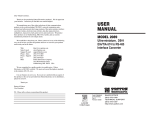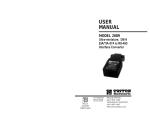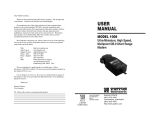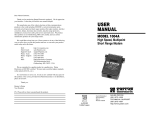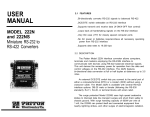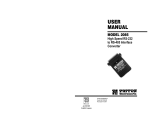Download Patton electronic MODEL 1012AR User's Manual
Transcript
USER M A N UA L MODEL 1012AR Asynchronous, Carrier Controlled Short Range Modem Part# 07M1012AR-A Doc# 040051UA Revised 11/22/94 SALES OFFICE (301) 975-1000 TECHNICAL SUPPORT (301) 975-1007 http://www.patton.com 1.0 WARRANTY INFORMATION 2.0 GENERAL INFORMAT I O N Patton Electronics warrants all Model 1012AR components to be free from defects, and will—at our option—repair or replace the product should it fail within one year from the first date of shipment. This warranty is limited to defects in workmanship or materials, and does not cover customer damage, abuse or unauthorized modification. If this product fails or does not perform as warranted, your sole recourse shall be repair or replacement as described above. Under no condition shall Patton Electronics be liable for any damages incurred by the use of this product. These damages include, but are not limited to, the following: lost profits, lost savings and incidental or consequential damages arising from the use of or inability to use this product. Patton Electronics specifically disclaims all other warranties, expressed or implied, and the installation or use of this product shall be deemed an acceptance of these terms by the user. Thank you for your purchase of this Patton Electronics product. This product has been thoroughly inspected and tested and is warranted for One Year parts and labor. If any questions or problems arise during installation or use of this product, please do not hesitate to contact Patton Electronics Technical Support at (301) 975-1007. 2.1 FEATURES • Allows up to 10 terminals to use a single port • Supports hardware handshaking • Full or half duplex, point-to-point or multipoint • Automatic equalization and gain control • Transformer isolation 1.1 RADIO AND TV INTERFERENCE The Model 1012AR generates and uses radio frequency energy, and if not installed and used properly—that is, in strict accordance with the manufacturer's instructions—may cause interference to radio and television reception. The Model 1012AR has been tested and found to comply with the limits for a Class A computing device in accordance with the specifications in Subpart J of Part 15 of FCC rules, which are designed to provide reasonable protection from such interference in a commercial installation. However, there is no guarantee that interference will not occur in a particular installation. If the Model 1012AR does cause interference to radio or television reception, which can be determined by disconnecting the RS-232 interface, the user is encouraged to try to correct the interference by one or more of the following measures: moving the computing equipment away from the receiver, re-orienting the receiving antenna and/or plugging the receiving equipment into a different AC outlet (such that the computing equipment and receiver are on different branches). 1.2 SERVICE All warranty and non-warranty repairs must be returned freight prepaid and insured to Patton Electronics. All returns must have a Return Materials Authorization number on the outside of the shipping container. This number may be obtained from Patton Electronics Technical Service at (301) 975-1007. Packages received without an RMA number will not be accepted. Patton Electronics' technical staff is also available to answer any questions that might arise concerning the installation or use of your Model 1012AR. Technical Service hours: 8AM to 5PM EST, Monday through Friday. 1 • No AC power required. Draws required low power from TIA-561 interface • Supports data rates to 38,400 bps, distances to 6 miles • Silicon Avalanche Diode surge protection - Standard • TIA-561 connection via 10-pin RJ-45 jack • Line connection via RJ-11 or 8-pin RJ-45 jack 2.2 DESCRIPTION The Patton Model 1012AR asynchronous short range modem was designed for point-to-point or multidrop applications requiring hardware handshaking. In a multipoint environment, the master transmits data simultaneously to up to 10 addressable terminals. The terminals contend for the main channel by activating RTS (pin 4). Automatic equalization and gain control ensure the accuracy of transmitted data. Built-in transformers eliminate much of the noise which can occur in commercial buildings. These transformers also eliminate ground loops caused by differences in reference ground. Consequently, the Model 1012AR may be used to extend RS-232 (TIA-561) distances in environments where connected equipment is located in different buildings. The 1012AR uses the latest in bi-directional, clamping, transient suppressors to protect itself and connected equipment against harmful transient surges. These suppressors can dissipate 600W per wire at 1.0 mS. Response times are typically 1.0 pS from 0 to the nominal breakdown level of 6.8 volts. 2 3.0 CONFIGURAT I O N 4.0 INSTA L L AT I O N The Model 1012AR is pre-configured at the factory to work in multipoint applications, and in point-to-point applications that use hardware flow control. These are the vast majority of applications that call for the Model 1012AR. Therefore, you will normally have no need to reconfigure the Model 1012AR: it will be strictly “plug-and-play”. The only user-modifiable setting on the Model 1012AR is the RTS control strap. The RTS control strap setting determines how its transmitter (i.e. carrier) is activated. When the RST control strap is ON (installed on the pins), the transmitter is enabled by activating RTS (RJ-45 pin 8). This is the factory setting.. When its strap is OFF (removed from the pins), the 1012AR’s transmitter is constantly on. If your application requires the transmitter to be constantly on (i.e. hardware flow control disabled), follow the instructions below: Step 1: Opening the Case. To open the Model 1012AR’s case, insert the blade of a small flat-head screw driver into the narrow slots on either side of the case and twist. The two case halves should pop apart. Then slide the case halves off of the two end inserts. This will expose the PC board. The Model 1012AR features modular connectors on both the EIA/TIA-561 and 4-wire (line) sides. The EIA/TIA-561 interface is always a 10 pin RJ-45 jack (although its physical size is identical to an 8-pin RJ-45 jack). A one foot RJ-45 patch cable, wired straight through, is supplied with the unit. The 4-wire interface may be a 6 pin RJ-11 jack or an 8 pin RJ-45 jack. 4.1 CONNECTION TO THE EIA/TIA-561 INTERFACE The Model 1012AR features a convenient, 10 pin RJ-45 jack for interface with your DTE device. This jack is wired as a DCE according to the EIA/TIA-561 specification. Figure 2 (below) shows the pins and signals for the modular EIA/TIA-561 interface. Note: Signal are named from the perspective of the DTE (PC/terminal). Therefore, even though pin 7 (below) is called “TD” , the signal is actually incoming to the DCE (Model 1012AR). 10 Pin RJ-45 (DCE) 1 2 3 4 5 6 7 8 9 10 Step 2: Setting the RTS Strap. On Figure 1 (below), you will see the location of the RTS strap on the PC board. To re-configure the Model 1012AR for transmitter constantly on, remove the strap by pulling it out with a pair of needle-nose pliers or tweezers. Be sure not to lose the strap. Step 3: Closing the Case. To close the Model 1012AR’s case, be sure the end inserts are in place around th modular jacks (“side”side closest to the clip) and slide th case halves down around them. Then snap the case halves shut. RTS/CTS Strap Surge Suppressors Figure 1. Model 1012AR board, showing the RTS strap location ----------------------N/C ----------------------RI ----------------------CD ----------------------DTR ----------------------SG ----------------------RD ----------------------TD ----------------------CTS ----------------------RTS ----------------------N/C DIRECTION Not Supported From 1012AR To 1012AR No Direction From 1012AR To 1012AR From 1012AR To 1012AR . Figure 2. Pin-outs for the Model 1012AR’s modular EIA/TIA-561 interface jack If you wish to use the Model 1012AR with a DTE device that is equipped with a DB-25 RS-232 port, you will need to construct a patch cable according to the diagram shown in Figure 3 (below). SIGNAL Isolation Transformers SIGNAL CD DTR SG RD TD CTS RTS 10 Pin RJ-45 (DCE) DB-25 (DTE) 3 ------------------------------8 4 ------------------------------20 5 ------------------------------7 6 ------------------------------3 7 ------------------------------2 8 ------------------------------5 9 ------------------------------9 SIGNAL CD DTR SG RD TD CTS RTS Figure 3. Pin connections for an EIA/TIA-561(RJ-45) to RS-232 (DB-25) patch cable. 3 4 4.2 CONNECTION TO THE 4-WIRE INTERFACE 4.3 MULTIPOINT CONNECTION The Model 1012AR offers RJ-11 and RJ-45 options for connection of the 4-wire data line. The signals/pins used are shown below: The Model 1012AR supports multi-point applications using either a star or a daisy chain topology. together in a master/slave arrangement. Maximum distance between the units will vary based upon the number of drops, data rate, wire gauge, etc. Call Technical Support for specific distance estimates. In both topologies, the master unit should be set to “transmitter constantly on” (strap removed), and the slaves should be set to “transmitter controlled by RTS” (strap in place). RJ-11 SIGNAL RJ-45 1 ------------GND† 2 ------------RCV3 ------------XMT+ 4 ------------XMT5 ------------RCV+ 6 ------------GND † SIGNAL 1 -----------N/C 2 -----------GND 3 -----------RCV4 -----------XMT+ 5 -----------XMT6 -----------RCV+ 7 -----------GND 8 -----------N/C 4.3.1 STAR TOPOLOGY Figure 4 (below) shows how to wire the two-pair cables properly for a Model 1012AR star topology. Note that the ground connection is not needed Connection to ground is optional HOST XMT+ FIRST SLAVE RCV+ SECOND SLAVE RCV+ 1 2 3 4 5 6 - 1 2 3 4 5 6 7 8 Blue Yellow Green Red Black White - Blue Orange Black Red Green Yellow Brown Slate XMT- RCVRCV- RCV+ XMT+ XMT+ RCV- XMT- 4.2.1 POINT-TO-POINT CONNECTION XMT- When installing two Model 1012AR units in a point-to-point application, the cable between them should be a crossover cable, as shown in the following chart. The color/pin number correlations below correspond to AT&T’s wiring standard for RJ-11 connectors. † ‡ SIGNAL PIN# COLOR GND† RCVXMT+ XMTRCV+ GND 1 2 3 4 5 6 Blue‡ --------------White Yellow ------------Red Green ------------Black Red ---------------Yellow Black -------------Green White -------------Blue COLOR PIN# Connection to ground is optional Standard color codes—yours may be different 5 6 4 5 2 3 1 SIGNAL GND XMTRCV+ RCVXMT+ GND Figure 4. Star wiring for Model 1012AR host and slaves 4.3.2 DAISY CHAIN TOPOLOGY Figure 5 (below) shows how to wire the two-pair cables properly for a Model 1012AR daisy-chain topology. Note that the ground connection is not needed. HOST XMT+ XMTRCV+ RCV- FIRST SLAVE RCV+ RCVXMT+ XMT- OTHER SLAVE(S) RCV+ RCVXMT+ XMT- Figure 5. Daisy chain wiring for Model 1012AR host and slaves 6 APPENDIX A PAT TON MODEL 1012AR SPECIFICATIONS Transmission Format: Transmission Line: Interface: Data Rates: Isolation: Surge Protection: Control Signals: RTS/CTS Delay: Connectors: Power Supply: Temperature Range: Altitude: Humidity: Weight: Dimensions: APPENDIX B PAT TON MODEL 1012AR BLOCK DIAGRAM Asynchronous, full duplex Two unconditioned twisted pair 19-26 AWG EIA/TIA 561 0 - 38.4 Kbps Minimum 1500 V RMS via custom transformers 600W power dissipation at 1 mS and response time of 1 pS CTS follows RTS from the terminal (DTE); DSR follows DTR from the terminal (DTE); DCD indicates reception of carrier Approximately 35 mS 10 Pin RJ-45 on EIA/TIA-561 side; RJ-11 or 8 pin RJ-45 on line side No external power required; uses power from EIA data and control signals 0-60°C (32-140°F) 0-15,000 feet 5 to 95% noncondensing 2 oz. 2.66” x 2.10” x 0.73” Distance Table (miles) Data Rate 38,400 19,200 9,600 4,800 2,400 1,200 19 6.0 6.0 6.0 6.0 6.0 6.0 Wire Gauge 24 4.0 4.0 4.0 4.0 4.0 4.0 26 2.5 2.5 2.5 2.5 2.5 2.5 Copyright © Patton Electronics Company All Rights Reserved 7 8





